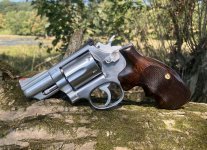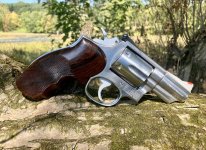I picked up a 66-1 snubbie today and started the cleaning process. After some soaking, I got all the screws out and parts removed. The gun was very dirty on the outside but otherwise showed very little signs of use. With the side plate off it looked quite clean but when the thumb piece bolt was removed I found a totally rusted bolt plunger spring. The plunger itself may be rusted as well but I just threw them in some oil to soak. I'm assuming the spring is simply carbon steel (probably the plunger as well) and got some moisture in there that just couldn't evaporate in time.
Metal rescue will remove all traces of rust and I will at least replace the spring.
Added 9/4 - I stand corrected. After getting back to the gun today I see that the spring is not rusted but the plunger is.
Metal rescue will remove all traces of rust and I will at least replace the spring.
Added 9/4 - I stand corrected. After getting back to the gun today I see that the spring is not rusted but the plunger is.
Last edited:


